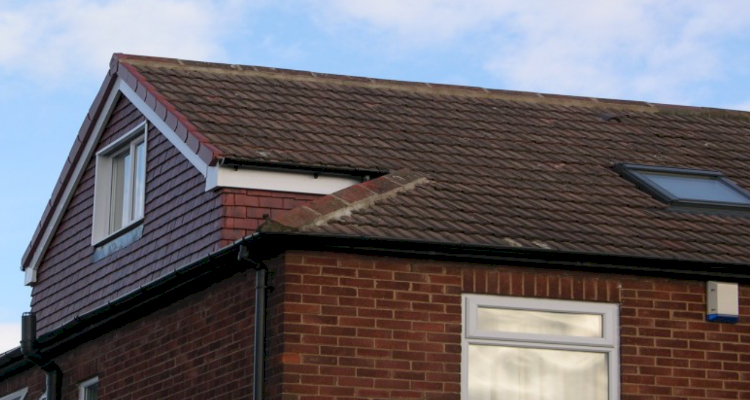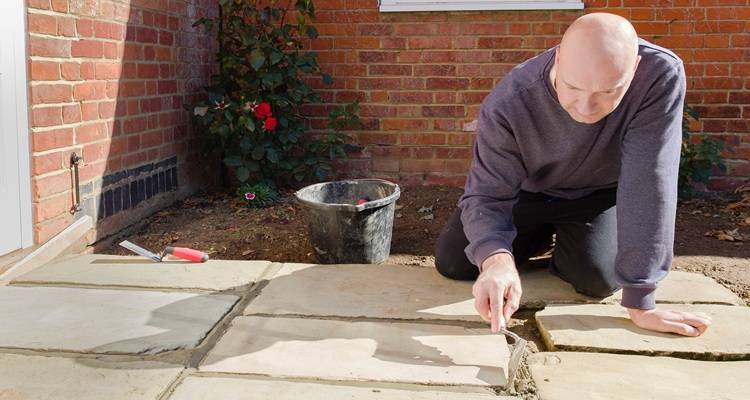Suspended Ceiling Cost
- The average cost of installing a false ceiling is £33 per m².
- It usually takes 6 to 8 hours to fit false ceilings.
- A complete false ceiling installation cost breakdown, including the cost per m² for different types of suspended ceilings.
- How long false ceiling installation takes, and a range of jobs you might like to do at the same time.
- How to find and hire a local suspended ceiling installer.
Are you considering installing a suspended ceiling or a false ceiling?
You can expect an average cost of £33 per m². In this guide, we'll take you through low, mid, and high-end false ceiling materials and their associated costs.
Ready to get a quote for false ceiling installation?
More than 1 million homeowners across the UK use MyJobQuote to find tradespeople near them every year.
Simply submit a few details about what you're thinking of doing, and we'll connect you with false ceiling installers near you for free, no obligation quotes.
Want to find out more before you start getting quotes? Keep reading!
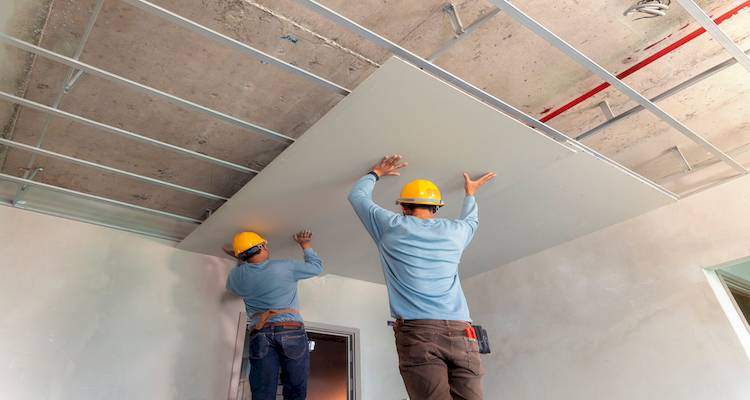
£33 per m²
Table of Contents
- How Much Does Installing a Suspended Ceiling Cost?
- Supply Only Costs
- Additional Costs
- Labour Costs and Timescales
- Cost Factors of Installing a False Ceiling
- What's Involved in Installing a False Ceiling?
- Can I Install a False/Suspended Ceiling Myself?
- Building Regulations & Planning Permission for Installing A Suspended Ceiling
- Types of False Ceiling
- Hiring Contractors for Installing A False/Suspended Ceiling Checklist
- FAQs
How Much Does Installing a Suspended Ceiling Cost?
In this article, we will go over everything you need to know about the costs involved with this type of work, including the supply costs, labour costs, and any additional costs that may come up.
We will also provide you with some additional information about false/suspended ceilings, such as the installation method, the cost factors of this work, the building regulations and planning permission rules, the different types of false or suspended ceilings, and some tips on hiring the right contractors for the job.
Suspended ceilings are most commonly used in industrial and commercial settings. However, they are becoming more and more common in residential spaces. They provide a very fast and easy way to cover up old and unattractive ceilings. They are versatile and can look very attractive when fitted right.
These types of ceilings are a great choice when you want to hide any unsightly pipes and wiring. Some varieties also come with fire-resistant properties. These ceilings can also help to improve the acoustics in your home and can provide insulation.
It's very unlikely that two suspended ceiling jobs will be the same, so it can be difficult to determine the price for this job. However, the average cost for a suspended ceiling is around £22 to £35 per m².
The price will vary depending on the size of your ceiling, the location of your property, and the materials used. If you are based in the London area, you can expect to pay more for this work than if you were based in the North or other parts of the UK.
False Ceiling Prices
Below is a table showing the average cost of a suspended ceiling:
| JOB DESCRIPTION | FALSE/SUSPENDED CEILING PRICES |
|---|---|
| Low-end suspended ceiling cost | £16 - £20 per m² |
| Mid-range suspended ceiling cost | £22 - £35 per m² |
| High-end suspended ceiling cost | £40 - £60 per m² |
| Insulation cost | £5 - £8 per m² |
Supply Only Costs
In some cases, you may be interested in learning more about the supply costs for this type of work. This may be the case if you are planning on installing the ceiling yourself or if you are planning on buying the materials upfront and then sourcing the contractors at a later date.
Suspended ceiling tiles cost varying amounts depending on the size, style, type, and material.
You can expect to pay around £4 to £10 per m² on average for suspended ceiling tiles. The price for the tiles will vary depending on the style and quality of the materials that they are made with.
Additional Costs
When it comes to installing a suspended or false ceiling, there are several additional costs that you may need to budget for. Below is a list of the additional things that you may need to consider with this type of work:
Additional Insulation
To improve your home's energy efficiency, you can add insulation to your new suspended ceiling. The cost of roof insulation is around £450, but will depend on the exact insulation material you choose.
You'll need to factor in the weight of the insulation, as suspended ceilings can't support as much weight as a standard ceiling.
New Light Fittings
Once your new suspended ceiling has been installed, you might be interested in adding a new light fitting to the ceiling. Light fittings can vary in design and cost, depending on the style and quality of light fitting you choose.
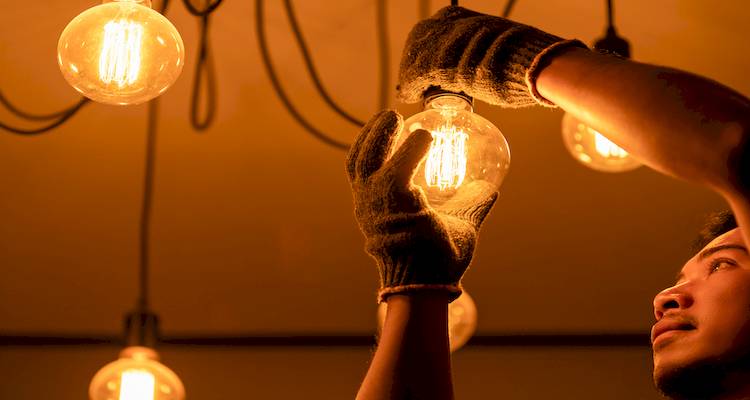
The average cost of installing new light fittings in a room is around £80 to £200.
If you're moving your electrical cables around to accommodate the suspended ceiling, you can also take advantage of your electrician being on-site and have a few other electrical jobs ticked off at the same time. The cost to install new plug sockets is just £75, and can help to add power to corners of your room.
Plastering
If the walls in the room look a bit old, uneven, and tired, you might need to plaster the walls before adding any additional décor to the room.
The price that you can expect to pay for plastering a room will depend on the size of the room. However, the cost of plastering one room ranges from £400 to £1,500 on average for this type of work.
Decorating a Room
If you are installing the suspended ceiling to improve the overall look of the room, you may also want to consider decorating the room in some more ways. This may include re-decorating the room.
Painting a room costs around £300 to £500. This price will depend on the quality of the paint and the size of the room. For a different style, you can opt for wallpapering instead, and the cost to have a room wallpapered is around £300.
Skip Hire
If you are replacing your existing suspended ceiling with a new suspended ceiling, then there is likely to be a lot of waste resulting from the removal of the old ceiling.
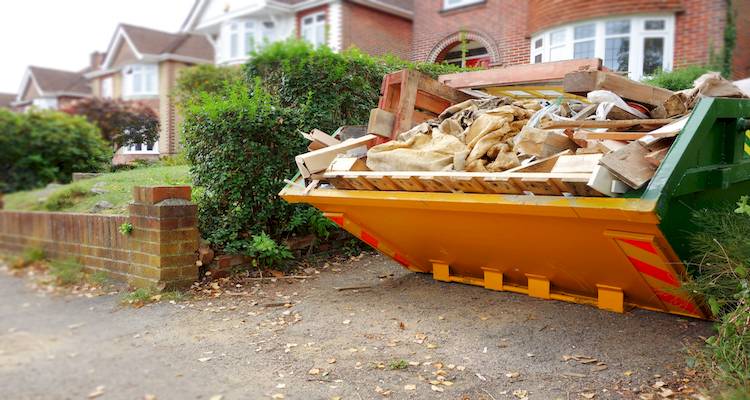
In these cases, you may need to hire a skip to get rid of all of the waste from the job. The average cost of hiring a skip for this type of work is around £150 to £300.
This price will depend on the amount of waste you need to remove and the length of time that you need to hire the skip.
Labour Costs and Timescales
If you are planning on buying the materials for the job separately and then hiring a contractor at a later date, you might then be interested in learning about the price that you might expect to pay for just the labour part of the job alone.
You might also be curious to learn about how long this type of work is expected to take.
You can expect the suspended ceiling specialist to charge around £150 to £200 per day, and a general labourer will charge around £80 to £100 per day.
If the job goes smoothly and no problems arise, your suspended ceiling installation will take no more than a day to complete. If the room is quite large, it may take up to two days.
Cost Factors of Installing a False Ceiling
There are several things that can affect the overall cost of installing a suspended ceiling. Below is a list of the things that may affect the cost of this job:
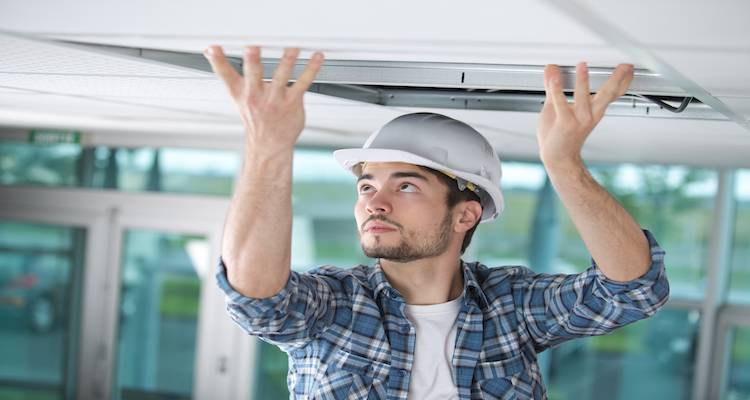
Quality of The Ceiling Tiles
The quality of the ceiling tiles will affect the overall cost of the job. As mentioned earlier, you can choose from low-range, mid-range, or high-range false ceiling panels. The tiles that you choose will determine the overall cost of the job.
Location of Property
The location of your property will also impact the overall cost of installing a suspended ceiling. Those based in and around the London area can expect to pay more for the labour part of the job than those based in the North or different areas of the UK.
This is due to the fact that labour costs in the London area tend to be higher across all industries than in other parts of the UK.
Number of Tradespeople
The number of tradespeople that are working on the job will also affect the job’s cost. More people might be required to work on the ceiling depending on the size and type of suspended ceiling that you choose. The more tradespeople that are needed for the work, the higher the overall price will be due to the additional labour costs.
What's Involved in Installing a False Ceiling?
If you are planning on installing your suspended ceiling yourself as a DIY project, then you may be interested in learning more about the steps that are involved with this type of work. Below is a guide on how to install a suspended ceiling:
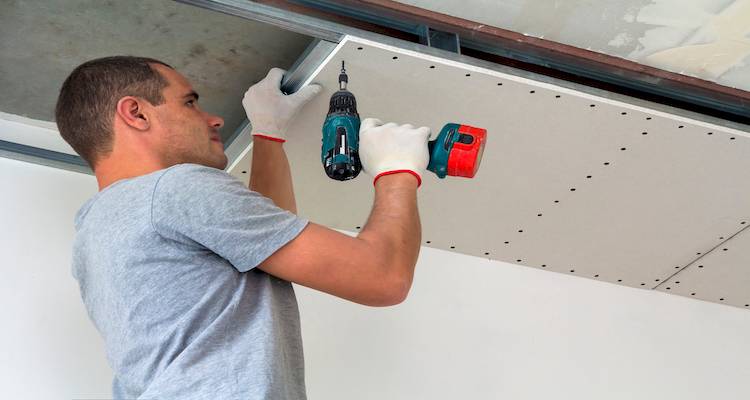
- Begin by calculating the height that your new ceiling will be. The minimum it needs to be is seven feet and six inches. It also needs to be three inches below any plumbing and five inches below any lighting. Snap a quick chalk line to mark the height and install the track supports around the perimeter of the walls.
- Use a hacksaw or tin snips to cut the main tees to the right length. Place these on the track supports and then hang them from the joists with number 12 wire attached to some eyes screws. These should be installed every four feet.
- Insert the tabs of the four-foot cross tees in the appropriate slots on the main tees. Shape these into place.
- Lower the solid panels gently into place and add any fluorescent false ceiling lighting panels that you may be installing. Wash your hands before handling the panels, as stains and smudges are difficult to remove.
Can I Install a False/Suspended Ceiling Myself?
If you feel confident in your DIY skills, then you should be able to install a suspended ceiling yourself successfully. However, you should avoid attempting this type of work if you are at all in doubt about your DIY skills.
In most cases, homeowners prefer to leave this type of work to the professionals for a high-quality finish and a safe final product.
Building Regulations & Planning Permission for Installing A Suspended Ceiling
When it comes to suspended or false ceilings, you won’t usually need to worry about planning permission. However, if you live in a listed building or a conservation area, you should check with your local authority for some advice before the work is carried out.
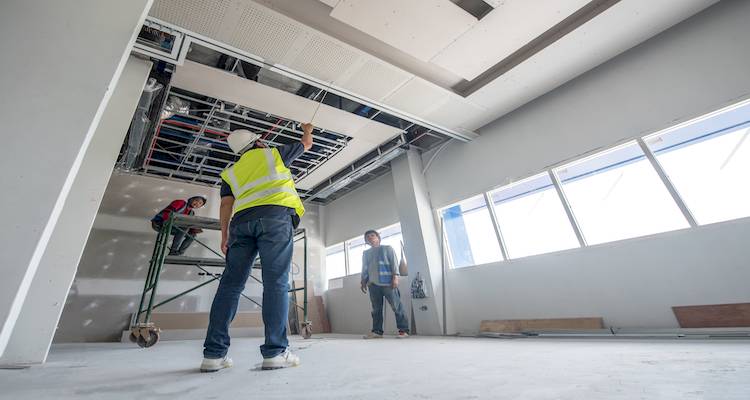
There are some rules that you will have to follow when installing a suspended ceiling. The minimum height it needs to be is seven feet and six inches. It also needs to be three inches below any plumbing and five inches below any lighting.
Types of False Ceiling
There are several different types of suspended ceiling materials. Below is a list of the various suspended ceiling types and the benefits of each type:
Plasterboard Suspended Ceiling
Plasterboard is one of the cheapest styles of suspended ceiling tiles. Gypsum plasterboard is a very robust type of material with good insulative qualities.
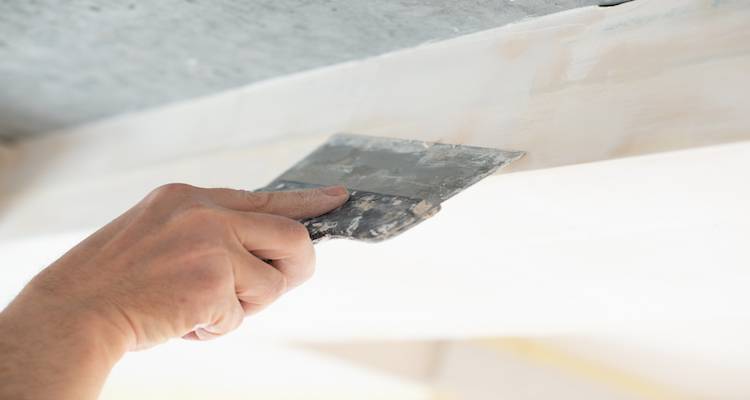
It is usually covered with a wipe-clean surface that makes it easy to maintain and is ideal for areas with high moisture exposure.
PROS
- ✔ One of the cheapest options
- ✔ Good insulation qualities
- ✔ Large range of finishes on offer
CONS
- ✖ Probably the least attractive type of suspended ceiling tile
Mineral Fibre Suspended Ceiling Tiles
Mineral fibre tiles can be found in different varieties and can be made from a range of different natural, synthetic, and recycled materials.
They are generally very good at absorbing sound, and they have great insulating properties. They are also one of the most cost-effective types of false ceiling tiles. However, these tiles can be quite heavy.
PROS
- ✔ One of the cheaper options
- ✔ Very good insulating qualities
- ✔ Good sound-proofing qualities
CONS
- ✖ It can be quite heavy
Metal Suspended Ceiling Tiles
Metal suspended ceiling tiles are one of the most visually striking types of suspended ceiling tiles. These are a popular choice for many homeowners. They are usually made from aluminium and can look very attractive.
They are also very durable and easy to maintain. They are usually paired with insulation sheets to help improve their thermal and sound-proofing qualities. These are usually the most expensive options for suspended ceiling tiles.
PROS
- ✔ Very attractive
- ✔ Durable and hard-wearing
- ✔ Light-reflective qualities
CONS
- ✖ Requires separate insulation
Plastic Suspended Ceiling Tiles
You can also get various plastic-suspended ceiling panels with different textures, colours, and finishes. Plastic ceiling tiles are usually quite cheap to buy. They are also very durable, moisture-resistant, and durable.
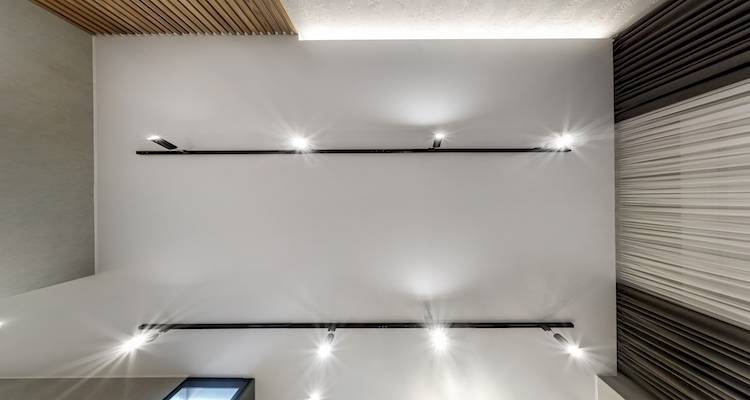
PROS
- ✔ Low-cost option
- ✔ Many different styles are available
- ✔ Durable
- ✔ Lightweight
CONS
- ✖ Not the most attractive option
Hiring Contractors for Installing A False/Suspended Ceiling Checklist
There are several things you may have to consider when hiring a contractor to install the suspended ceiling for you. Below is a list of some of the main things that you should consider when finding the right contractors for the job:
- Do the contractors provide any guarantees with their work, and what is included in this guarantee?
- How much does the work cost to complete? – Ask for a breakdown of costs so you can be sure you are paying a good price for each element of the job
- Are the contractors experienced in installing the type of suspended ceiling that you require?
- How much experience does the contractor have in installing suspended ceilings?
- Will the contractor fix any issues that may arise?
- Do you need to hire any additional contractors for any parts of the job?
- Do you need to provide anything to the contractors for the work?
- How long will the work take to complete?
- Can the contractors provide any photos of their previous work?
- Will the contractors take care of any relevant waste removal as part of the job?
FAQs
What is a false ceiling?
There is usually a hollow space left between the new false ceiling and the original ceiling. This can be very useful for insulating and soundproofing.
What are suspended ceiling tiles made of?
What are the most common types of suspended ceiling tiles?
What are suspended ceiling tiles?
Can a suspended ceiling be painted?
If you would like a different colour for your ceiling, it may be easier, quicker, and cheaper to simply replace the tiles with new ones rather than painting them.
How do I stop my tiles from lifting in the wind when I open the external door?
You can also choose to clip the tiles in place using some universal hold-down clips. This will help hold the tiles down and prevent them from lifting out of place if wind enters the property.



